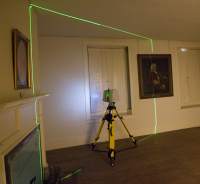President Lincoln's Cottage in Washington D.C. to be 3D Laser Scanned for
the first time by Profs. Rogers & Stull and undergraduate researchers
Kevin Coldren & Evan Van de Wall
12/23/14
Contributed by Michael 'Bodhi' Rogers
 3D laser scanning uses a pulsed laser to record the x, y, and z location of objects it strikes to a precision of ~1 mm while taking readings every millimeter. The resultant point clouds support preservation plans, research, virtual tours, and public outreach.
3D laser scanning uses a pulsed laser to record the x, y, and z location of objects it strikes to a precision of ~1 mm while taking readings every millimeter. The resultant point clouds support preservation plans, research, virtual tours, and public outreach.
The website for President Lincoln's Cottage gives an excellent description of the historical significance of the site: "President Lincoln developed the Emancipation Proclamation while living in a Gothic Revival Cottage at the Soldiers’ Home in Washington, DC. Lincoln’s time at the Cottage served as bookends for Civil War — he first visited the grounds three days after his inauguration and last rode out to the site the day before his assassination. While living at the Cottage for 13 months from June-November of 1862-1864, Lincoln regularly commuted to the White House. The Cottage opened to the public in 2008, and is run by the National Trust for Historic Preservation, a private, non-profit organization, through an agreement with the Armed Forces Retirement Home."
The Ithaca College 3D laser scanning team will spend 7 days scanning the outside and inside of the building. They will use a Leica C-10 3D laser scanning that takes 50,000 reading per second and supplemental digital photographs. The team anticipates generating ~10 GB of data per each day of the trip that will record all aspects of the building in the highest resolution to date.
The image included with this posting is from a similar project at the Old Fort Johnson National Landmark site west of Albany, NY. The green line in the photograph is the laser from the scanner recording measurements. Because the scanner can process data so quickly the laser pulses show up as a continuous line.
2 Comments
https://www.ithaca.edu/intercom/article.php/20141223204742929
 3D laser scanning uses a pulsed laser to record the x, y, and z location of objects it strikes to a precision of ~1 mm while taking readings every millimeter. The resultant point clouds support preservation plans, research, virtual tours, and public outreach.
3D laser scanning uses a pulsed laser to record the x, y, and z location of objects it strikes to a precision of ~1 mm while taking readings every millimeter. The resultant point clouds support preservation plans, research, virtual tours, and public outreach.